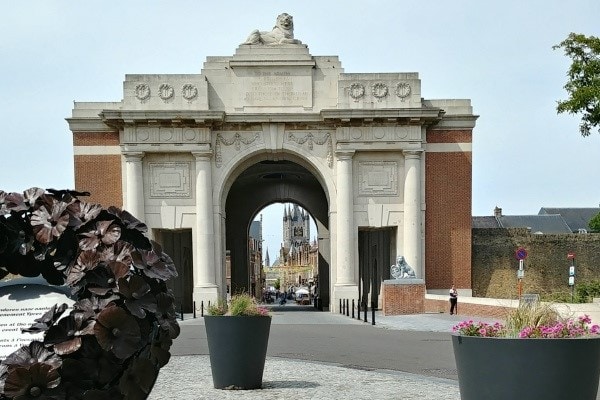It’s been a century since Niagara-on-the-Lake’s iconic clock tower cenotaph was erected. Then, in 1926, the Township of Niagara unveiled its own memorial in Queenston. In recognition of those who fought and died in two world wars and beyond, NOTL historian Ron Dale has been researching the stories of the people – all men – whose names are engraved on the two cenotaphs. This is one in a series of stories documenting and remembering the sacrifices of those commemorated on the municipal memorial in Queenston.
_________________
The Niagara-on-the-Lake Museum preserves thousands of artifacts related to local history going back thousands of years. It is an amazing collection.
Among the items preserved and catalogued are two medals from the First World War, issued posthumously to James William Wilmott. He was a private in the British Army, serving in the 1st Battalion of the East Lancashire Regiment.
James Wilmott was born on Sept.27, 1885, in London, England, one of several children of labourer George Charles Wilmott and his wife Maria Fossey.
Sadly, Maria died in 1896, leaving George with four young children, including 13-year-old James and his five-year-old brother Arthur. George was unable to care for these children and they were placed in workhouses. He lived until 1932 but does not seem to have reconnected with his children.
In 1866, philanthropist Thomas John Barnardo founded the National Incorporated Association for the Reclamation of Destitute Waif Children. Barnardo set out to aid and assist destitute and orphaned children by shipping them to Canada to work as indentured farm labourers or domestic servants.
One of these “Bernardo Boys,” Arthur Wilmott, was shipped to Canada by the Barnardo organization in the spring of 1904. The 13-year-old boy was sent to a fruit farm in Niagara Township to work as a labourer. He received room and board and a modest pay for his labours.
In 1910, his brother James joined him in Canada. James was 24 at the time and was supervising a great number of young teenaged “Barnardo Boys” being shipped to Canada aboard the SS Sicilian. Presumably he was now an employee of the Barnardo organization.
James and Arthur seemed to have done well. By 1913 the brothers owned a little over 14 acres of orchard in Niagara Township.
When the First World War broke out in August 1914, James immediately felt the call of “King and Country” and the need to enlist to defend his mother country.
While many other relatively recent immigrants from Britain enlisted in the Canadian Expeditionary Force, James took a different route. He sailed to England and joined the Royal Army there.
He enlisted in the 1st Battalion of the East Lancashire Regiment and after a relatively short training period was sent to the continent to join the small British Expeditionary Force, which was assisting the French in trying to stem the tide of a major German invasion.
The British Expeditionary Force was small in numbers. Britain put most of its spending on defence toward the Royal Navy and little toward the Royal Army.
German Kaiser Wilhelm II of Germany referred to them in August 1914 as “a contemptible little army.” The soldiers adopted this as a badge and referred to the men who fought in 1914 until 1915 as the “Old Contemptibles.”
A medal was struck to honour these men, the “1914-15 Star,” known by the soldiers as the “Mons Star” due to the heroics of the British Expeditionary Force on the retreat from Mons in 1914. A Mons Star was cast for James Wilmott, with his name, unit and regimental number engraved on the back.
He fought in the Second Battle of Ypres, April 22 to May 25, 1915, which where the Germans first used poison gas as a weapon. The casualties on both sides were extremely heavy.
In a major phase of this month-long battle at Aubers Ridge on May 9, the East Lancashire regiment suffered 449 casualties.
Wilmott survived these bloody actions but was killed in “No Man’s Land” during a British assault on the German trenches on May 12, 1915.
His body was never identified and his final resting spot remains unknown. His name is engraved on the Menin Gate in Ypres along with 34,983 Commonwealth soldiers whose graves are “known only to God.”
James Wilmott’s effects were shipped to his brother Arthur in Niagara, his sole legatee. Arthur ensured that James Wilmott’s name was included on the Township War Memorial in Queenston.
The Victory medal and war medal belonging to James were donated to the Niagara-on-the-Lake Museum by the estate of the late Dorothy Webb of Niagara Falls. The location of his Mons Star is unknown.












